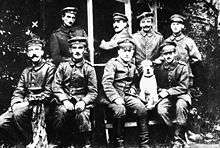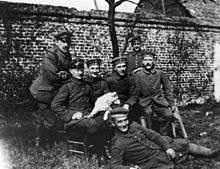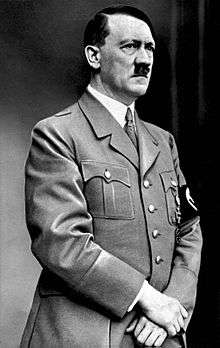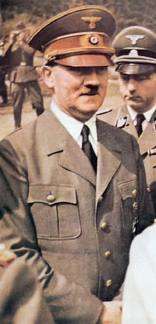Military career of Adolf Hitler
| Adolf Hitler | |
|---|---|
 Adolf Hitler during the First World War. | |
| Allegiance |
|
| Service/branch |
|
| Years of service | 1914–1920 |
| Rank | Gefreiter |
| Unit |
|
| Battles/wars | |
| Awards |
|

The military career of Adolf Hitler can be divided into two distinct portions of Adolf Hitler's life. Mainly, the period during World War I when Hitler served as a Gefreiter (lance corporal) in the Bavarian Army, and the era of World War II when Hitler served as the Supreme Commander-in-Chief of the Wehrmacht (German Armed Forces) through his position as Führer of Nazi Germany.
World War I
Hitler received the final part of his father's estate in May 1913 and moved to Munich, where he earned money painting architectural scenes. He may have left Vienna to evade conscription into the Austrian Army.[1] Hitler later claimed that he did not wish to serve the Habsburg Empire because of the "mixture of races" in its army. The Bavarian police sent him back to Salzburg for induction into the Austrian Army, but he failed his physical exam on 5 February 1914 and returned to Munich.[1]
He was 25 years old in August 1914, when Austria-Hungary and the German Empire entered into the First World War. Because of his Austrian citizenship, he had to request permission to serve in the Bavarian Army. Permission was granted.[2] Hitler almost certainly was enlisted by an error on behalf of the government. This is based on a report by the Bavarian authorities in 1924, which questioned how Hitler was allowed to serve in the Bavarian Army. They could not explain why he was not deported back to Austria in 1914 after he failed his physical exam for the Austrian Army and concluded that Hitler's citizenship was simply not raised, thus he was allowed to enter the Bavarian Army.[3] In the army, Hitler continued to put forth his German nationalist ideas which he developed from a young age.[4]
During the war, Hitler served in France and Belgium in the 16th Bavarian Reserve Regiment. He was an infantryman in the 1st Company during the First Battle of Ypres (October 1914), which is remembered in Germany as the Kindermord bei Ypern (Massacre of the Innocents) because approximately 40,000 men (between a third and a half) of nine newly enlisted infantry divisions were killed in 20 days. Hitler's regiment entered the battle with 3,600 men and at its end mustered 611.[5] The regimental commander was killed and thereafter they were known as the Regiment List in his honor. By December, Hitler's own company of 250 was reduced to 42. Biographer John Keegan claims that this experience drove Hitler to become aloof and withdrawn for the remaining years of war.[6] After the battle, Hitler was promoted from Schütze (Private) to Gefreiter (Lance Corporal) and assigned to be a regimental message runner.


Some regard this assignment as "a relatively safe job", because regimental headquarters was often several miles behind the Front.[7] According to Thomas Weber of the University of Aberdeen, earlier historians of the period had not distinguished between regimental runners, who were based away from the front "in relative comfort", and company, or battalion runners, who moved among the trenches and were more often under fire.[7]
It is scarcely surprising that those living in the trenches envied those in the rear. But relative comfort and safety distract from recognizing a decisive step in Hitler's rise to the command of the German armed forces. Regimental headquarters became the classroom in which he obtained his on-the-job military education. For almost four years, he was allowed to read incoming orders, directives and outgoing orders. He studied military history and theory and discussed his ideas with the officers. He researched the capabilities of German and Allied weapons in detail, learned the muzzle velocities and ranges of artillery tubes and machine guns, as well as the horsepower and carrying capacities of the new trucks and automobiles. After the List Regiment was attacked by British tanks near Ypres on July 31, 1917[8] he studied them also. Messengers' duties changed as the army on the Western Front settled into the defense. Fewer messages went by foot or bicycle and more so done by telephone. However, whenever a circuit went out of action, two messengers were sent to repair the break; this usually occurred during a bombardment. His circle of close army friends shown in the photographs were also at headquarters. They laughed at "Adi" for his aversion to smutty stories and traded their jam rations for his tobacco.[lower-alpha 1]
In early 1915, he adopted a stray dog he named Fuchsl (little fox), who was taught many tricks and became his beloved companion. Hitler described him as a "proper circus dog". In August 1917, the List Regiment was transferred to a quiet sector in Alsace. During the journey, both Fuchsl and Hitler's portfolio of sketches and paintings were stolen.[10] Hitler was heartbroken by his loss, but did take his first leave, which consisted of an 18-day visit to Berlin. where he stayed with the family of a comrade.[11]
The List regiment fought in many battles, including the First Battle of Ypres, the Battle of the Somme, the Battle of Arras, and the Battle of Passchendaele.[12] During the Battle of Fromelles on 19–20 July 1916 the Bavarians were assaulted by the Australians who were mounting their first attack in France. They were repulsed, suffering the second highest losses they had in any day on the Western Front, about 7,000 men.[13] The history of the List Regiment hailed this brilliant defense as the "personification of the German Army on the Western Front".[14]
At the Nuremberg Trials, two of his former superiors testified that Hitler had refused to be considered for promotion.[15] Hitler was twice decorated for bravery. He received the relatively common Iron Cross, Second Class, in 1914 and Iron Cross, First Class, in 1918, an honour rarely given to a Gefreiter.[16] Hitler's First Class Iron Cross was recommended by Hugo Gutmann, a Jewish List adjutant.[17] According to Weber, this rare award was commonly awarded to those posted to regimental headquarters, such as Hitler, who had contact with more senior officers than combat soldiers.[7] Hitler's Iron Cross, First Class was awarded after an attack in open warfare during which messengers were indispensable and on a day in which the depleted regiment lost 60 killed and 211 wounded.[18]

During the Battle of the Somme in October 1916, he was wounded in the left thigh when a shell exploded at the entrance to the dispatch runners' dugout.[19] He begged not to be evacuated,[20] but was sent for almost two months to the Red Cross hospital at Beelitz. Thereafter, he was ordered to the depot in Munich. He wrote to his commanding officer, Hauptmann Fritz Wiedemann, asking that he be recalled to the regiment because he could not tolerate Munich when he knew his comrades were at the Front.[21] Wiedemann arranged for his return to his regiment on 5 March 1917.[11]
On 15 October 1918, he and several comrades were temporarily blinded —and according to Friedelind Wagner[22] Hitler also lost his voice— due to a British mustard gas attack. After initial treatment, Hitler was hospitalized in Pasewalk.[23] While there on 10 November, Hitler learned of Germany's defeat from a pastor, and—by his own account—on receiving this news he suffered a second bout of blindness.[24] Hitler was outraged by the subsequent Treaty of Versailles, which forced Germany to state that they had started the war, deprived Germany of various territories, demilitarised the Rhineland, which was occupied by the Allies, and imposed economically damaging sanctions. Hitler later wrote, "When I was confined to bed, the idea came to me that I would liberate Germany, that I would make it great. I knew immediately that it would be realized."[25] However, it is unlikely that he committed himself to a career in politics at that point in time.[26]
Hitler wanted to remain in the army after the war, but this was impossible with the near total demilitarisation of the armed forces. He returned to Munich for demobilization.[27] In July 1919, he was appointed Verbindungsmann (intelligence agent) of an Aufklärungskommando (reconnaissance commando) of the Reichswehr, to influence other soldiers and to infiltrate the German Workers' Party (DAP). While monitoring the activities of the DAP, Hitler became attracted to the founder Anton Drexler's antisemitic, nationalist, anti-capitalist, and anti-Marxist ideas.[28] Impressed with Hitler's oratory skills, Drexler invited him to join the DAP, which Hitler did on 12 September 1919.[29]
Paramilitary career

After Hitler became the leader of the Nazi Party, he began acquiring paramilitary-like titles and using Nazi Party paramilitary uniforms to denote his position. Hitler's main title within the Nazi Party was simply that of Führer (leader) and there was never any special uniform designed for Hitler's position, although a rank pin for a civilian lapel (used by Hitler until 1934) was known as the "Eagle of Sovereignty Pin".[30] Hitler ceased wearing this pin after the Night of Long Knives due to widespread issuance of the Golden Party Badge and Hitler's preference for this decoration. The brown Nazi Party uniform that Hitler is most often associated with was a paramilitary uniform of the SA and denoted Hitler's position as Oberste SA-Führer. In the late 1920s, Hitler occasionally wore a black uniform, but this was during a period when Hitler was emulating Benito Mussolini. Hitler's admiration for the Italian dictator later faded as Germany became more powerful than her Italian ally and Mussolini was, in the end, looked down upon by Hitler as a puppet-dictator under German control.
Hitler was, by default as Führer, the supreme commander of every Nazi paramilitary organization, but he never adopted extra ranks in these organizations nor did he have special uniforms to denote his position (for instance, there was no special SS uniform or insignia for Hitler, even though he was considered SS member #1 and outranked Heinrich Himmler). Hitler also technically qualified for every Nazi political decoration, but in practice only wore his World War I Iron Cross, the Golden Nazi Party Pin, and the Wound badge in Black. During Nazi rallies at Nuremberg in the early 1930s, Hitler temporarily wore the 1929 Nuremberg Party Day Badge, but discontinued this after about 1935.
Rearmament
Six days after being sworn in as Chancellor in 1933, Hitler met with the German military leaders, declaring that his first priority was rearmament.[31] The new Defense Minister, General Werner von Blomberg, introduced Nazi principles into the armed forces, emphasizing the concept of Volksgemeinschaft (national community), in which Germans were united in a society without classes.[32] "The uniform makes all men equal."[33] Military rank specified a chain of command, not class boundaries. Officers were instructed to mingle with other ranks. Blomberg's decree on the army and National Socialism on 25 May 1934 ordered: "When non-commissioned officers and men take part in any festivity, care must be taken that the officers do not all sit together. I request that this guidance be given the most serious attention."[34] The rapidly expanding armed forces enlisted many new officers and men from the Hitler Youth. The American William L. Shirer reported that all ranks ate the same rations, socialized when off duty, and that officers were concerned with their men's personal problems.[35]
On 1 August 1934, a new law stated that on Hindenburg's death the presidency would be abolished, and its powers merged with those of the Chancellor. From that day onward, Hitler would be known as Führer and Reich Chancellor. As head of state, Hitler became supreme commander of all armed forces.[36] Hindenburg died the following day. (The new office was confirmed by a plebiscite on 19 August 1934.) Blomberg, on his own initiative, introduced the Oath of 2 August 1934: "I swear by God this sacred oath that I will render unconditional obedience to the Führer of the German Reich and people, Adolf Hitler, the commander in chief of the armed forces, and, as a brave soldier, will be prepared at all times to stake my life for this oath." (In 1939, God was removed from the oath.[37]) The Reichswehr was reorganized as the Wehrmacht on 21 May 1935, bringing the army, navy and air force under unified command.
Hitler guided the steps of their rearmament, thanks to his retentive memory, and interest in technical questions. General Alfred Jodl wrote that Hitler's "astounding technical and tactical vision led him also to become the creator of modern weaponry for the army".[38] He hammered home arguments by reciting long passages from Frederick the Great and other military thinkers. "Although the generals might at times refer to Hitler as a 'facile amateur', he was so far as an understanding of military history and weapons technology went, better educated and equipped than most of them."[39] On 4 February 1938, after Blomberg's disgrace and retirement, Hitler announced in a decree: "From henceforth I exercise personally the immediate command over the whole armed forces."[40] He abolished the War Ministry and took Blomberg's other title, Commander-in-Chief, for himself. By that year's end, the army had more than 1 million men and 25,000 officers.
World War II
When World War II began, Hitler appointed himself to the unique title "First Soldier of the German Reich" (Erster Soldat des Deutschen Reiches) and began wearing a gray military jacket with swastika eagle sewn on the upper left sleeve (contrary to anachronistic depictions in movies and popular culture, Hitler did not wear a brown Nazi party uniform at any point during World War II). Throughout the war, the only military decorations Hitler displayed were his Wound Badge and Iron Cross from World War I and the Nazi Golden Party Badge. Hitler's position in World War II was essentially supreme commander of the German Armed Forces (Oberbefehlshaber der Deutschen Wehrmacht).
After ordering the preparations for the attack on Poland, he scrutinized all of the orders the staff prepared for the first three days of operations down to the regimental level. He rewrote the plans for the capture of a crucial bridge, making them much bolder.[41] His status with the military escalated when they seized Norway and conquered Western Europe, with the major thrust coming through the Ardennes, which he had implemented despite the misgivings of many professional advisers.[42]
On 19 December 1941, Hitler appointed himself Commander-in-Chief of the German Army (Heer), thus taking a direct operational posting usually held by a full German general. Overconfident in his own military expertise following the earlier victories in 1940, Hitler became distrustful of his Army High Command and began to interfere in military and tactical planning with damaging consequences.[43] By late 1942, he began to make disastrous mistakes.[43] The historian who wrote the Wehrmacht war diary concluded that, "... within him the tension between rational insight and emotional delusion was never resolved", and that he was one of the "terrible simplifiers who thought to reduce the complexity of life to the dogmas they had worked out."[44] Late in the war by 22 April 1945, Hitler told Generals Wilhelm Keitel and Jodl that he had no further orders to give.[45]
Awards and decorations of Adolf Hitler

Decorations from World War I
- Iron Cross, Second Class - 12 February 1915
- Bavarian Cross of Military Merit, Third Class with Swords - 17 September 1917
- Regimental Diploma (Regiment "List") - 5 May 1918
- Wound Badge in Black - 18 May 1918
- Iron Cross, First Class - 4 August 1918
- Bavarian Medal of Military Service, Third Class - 25 August 1918
- Cross of Honor with Swords - 13 July 1934 (retroactively awarded to all war veterans)
After the end of the war, the only decorations Hitler regularly wore were the Wound Badge and First Class Iron Cross.
Nazi Party Political Badges
The party badges listed below are those Hitler had received and sometimes wore on his various party uniforms. In 1936, their order of precedence was set,[46] but by 1938 the Golden Party Badge was the only one he wore on a regular basis.
- Nuremberg Party Day Badge - 1929
- Brunswick Rally Badge - 1931
- Coburg Badge - 1932
- Golden Party Badge - 1933
- Blood Order - 1934
- SS Zivilabzeichen (#1) - 1934
The Eagle of Sovereignty Pin was a civilian lapel pin that denoted Hitler's rank of Führer; Hitler appears to have worn this lapel pin for social occasions between 1933 and 1935.
Political Awards bestowed but not worn
Hitler was technically entitled to several additional Nazi Party political decorations and had the right to wear such awards on his uniform. The decorations listed below were technically awarded to Hitler, but were never displayed on his uniforms.
- Nazi Party Long Service Award (25 years)
- Nazi Gau Badges[lower-alpha 2]
- Golden Hitler Youth Badge (with oak-leaves)[lower-alpha 3]
- Honour Chevron for the Old Guard
Civilian decorations of Nazi Germany
Hitler never wore any German civil decorations, and indeed did not qualify for most of them. Technically, Hitler was awarded the Olympic Games Decoration for serving as host at the 1936 Olympics, but he never wore or even acknowledged having received this award.
Military decorations of World War II
Hitler's stance on Second World War military decorations was that the Nazi leadership was the "fount" from which awards were granted. The leading Nazis did not need to bestow high ranking medals and awards on themselves, but should rather reserve such decorations for the younger generation of the movement. This was a point of contention between Hitler and Hermann Göring, the latter of whom attempted during the War to amass every conceivable German military, civil, and political decoration to wear on his Luftwaffe uniform. Reichsmarschall Göring's passion for collecting medals reached its climax in 1944, when Hitler denied him the Knights Cross of the War Merit Cross, which Göring had attempted to obtain for himself as a reward for his various government and military services.
Hitler himself never received a high level World War II military decoration, such as the 1939 Iron Cross, the Knight's Cross of the Iron Cross, the German Cross, or the War Merit Cross. However, by his appointment as Supreme Commander of the Wehrmacht and Commander-in-Chief of the Army, Hitler automatically qualified for some military service decorations, although he never wore such awards or even acknowledged his right to wear them.
In all, the following were World War II military decorations Hitler was automatically awarded by default:
- Anschluss Medal
- Sudetenland Medal (w/Prague Castle bar)
- Memel Medal
- West Wall Medal (w/1944 bar)
Hitler was not qualified to receive the Eastern Front Medal since, although he had planned the campaign, he did not spend enough time on the front lines to earn it. Due to the July 20 Plot, Hitler automatically qualified for the "Wound Badge of 20 July 1944" although he never wore this medal, choosing instead to wear his Wound Badge in Black dating from the First World War.
Notes
- ↑ Two of them joined him in 1940 after the victory over France and the Low Countries for a nostalgic tour of their old haunts in Flanders.[9]
- ↑ Hitler was automatically entitled to the highest degree of every Nazi Party Gau (District) Badge. Some Gauleiters ordered "special degrees" of Gau Badges, specifically for Hitler, some of which were gold encrusted with diamonds. Hitler was formally presented many of these badges, but wore none of them (in all, there were eleven Gau badges to which Hitler was entitled).
- ↑ Some reports indicate that Hitler did indeed wear this pin at various Hitler Youth functions.
References
- 1 2 Shirer 1960, p. 27.
- ↑ Weber 2010, p. 16.
- ↑ Kershaw 2001, pp. 90, 99.
- ↑ Evans 2003, pp. 163–164.
- ↑ Solleder, 1932
- ↑ Keegan 1987, p. 239.
- 1 2 3 "Adolf Hitler a war hero? Anything but, said first world war comrades: Unpublished letters and diaries from List regiment soldiers portray Hitler as a loner, an object of ridicule and 'a rear area pig'", The Guardian, 16 August 2010
- ↑ Meyer, A/ (1934) Mit Adolf Hitler im Bayr. R.I.R. 16 List, Neustat-Aisch:Georg Apperle
- ↑ Kershaw 2000, p. 299.
- ↑ Joachimsthaler, A. (1989) Korrektur einer Biographie. Adolf Hitler 1908-1920_,München:Herbig, pp. 141-144
- 1 2 Kershaw 2008, p. 58.
- ↑ Shirer 1960, p. 30.
- ↑ Weber, 2010, p. 156
- ↑ Solleder, 1932, p. 114
- ↑ Kershaw 91
- ↑ Bullock 1962, pp. 52–53.
- ↑ Kershaw 2008, p. 59.
- ↑ Meyer, A. (1934) Mit Adolf Hitler im Bayr. R.I.R. 16 List, Neustat-Aisch: Georg Apperle
- ↑ Kershaw 2008, p. 57.
- ↑ weidmann 29
- ↑ Langer 1972, p. 135-136.
- ↑ Langer 1972, p. 136.
- ↑ Kershaw 2008, pp. 59-60.
- ↑ Kershaw 2008, pp. 60, 62.
- ↑ Langer 1972, p. 37.
- ↑ Kershaw 2008, p. 64.
- ↑ Kershaw 2008, pp. 64-66.
- ↑ Kershaw 2008, p. 82.
- ↑ Stackelberg 2007, p. 9.
- ↑ Speer 1970.
- ↑ Kershaw 1998, p. 441.
- ↑ Messerschmidt, M. (1969). Die Wehrmacht im NS-staat. Zeit der indoctrination, Hamburg:Decker's Verlag, pp. 18-47
- ↑ Schoenbaum, D.(1967). Hitler's social revolution. Class and Status in Nazi Germany 1933-1939, London, Weidenfeld and Nicolson, p. 68
- ↑ O'Neill, R. J. (1966). The German Army and the Nazi Party, 1933-1939, London: Cassell, p. 65
- ↑ Shirer, W.S. (1941). Berlin Diary, London: Hamish Hamilton, p. 346
- ↑ Strawson, 1971, p. 43
- ↑ Rosinski, H. (1939). The German Army, London: Hogarth Press, p. 237
- ↑ Schramm, P. E. (1972). Hitler. The Man and the Military Leader, London: Allen Lane, The Penquin Press, p. 104
- ↑ Strawson, 1971, p. 51
- ↑ Strawson, 1971, p. 66
- ↑ Strawson, 1971, p. 92
- ↑ Schramm, 1972, p. 148
- 1 2 Kershaw 2001, p. 417.
- ↑ Schramm, 1972, p. 161 and p. 94
- ↑ Strawson, 1971, p. 226
- ↑ Nuremberg Party Day Badge of 1929
Bibliography
- Bullock, Alan (1962) [1952]. Hitler: A Study in Tyranny. London: Penguin Books. ISBN 978-0-14-013564-0.
- Evans, Richard J. (2003). The Coming of the Third Reich. Penguin Group. ISBN 978-0-14-303469-8.
- Keegan, John (1987). The Mask of Command: A Study of Generalship. London: Pimlico. ISBN 978-0-7126-6526-1.
- Kershaw, Ian (1999) [1998]. Hitler: 1889–1936: Hubris. New York: W. W. Norton & Company. ISBN 978-0-393-04671-7.
- Kershaw, Ian (2001). Hitler 1889-1936: Hubris. Penguin Books Limited. ISBN 978-0-14-192579-0.
- Kershaw, Ian (2008). Hitler: A Biography. New York: W. W. Norton & Company. ISBN 978-0-393-06757-6.
- Langer, Walter C. (1972) [1943]. The Mind of Adolf Hitler: The Secret Wartime Report. New York: Basic Books. ISBN 978-0-465-04620-1.
- Schramm, Percy E. (1972). Hitler. The Man and the Military Leader. London: Allen Lane The Penguin Press.
- Shirer, William L. (1960). The Rise and Fall of the Third Reich. New York: Simon & Schuster. ISBN 978-0-671-62420-0.
- Solleder, Fridolin (1932). Vier Jahre Westfront. Geschichte des Regiments List R. J. R. 16. München: Verlag Max Schrift.
- Speer, Albert (1970). Inside the Third Reich. New York: Macmillan. ISBN 0-297-00015-2.
- Stackelberg, Roderick (2007). The Routledge Companion to Nazi Germany. New York: Routledge. ISBN 978-0-415-30860-1.
- Strawson, John (1971). Hitler as Military Commander. London: B. T. Bastford.
- Van der Kloot, William (2008). The Lessons of War. Stroud: The History Press. ISBN 978-1-84588-634-9.
- Weber, Thomas (2010). Hitler's First War. New York: Oxford University Press. ISBN 978-0-19-923320-5.
- Zentner, Christian Ed; Bedürftig, Friedemann Ed (1991), The Encyclopedia of the Third Reich, New York: Macmillan. ISBN 0-02-897502-2.